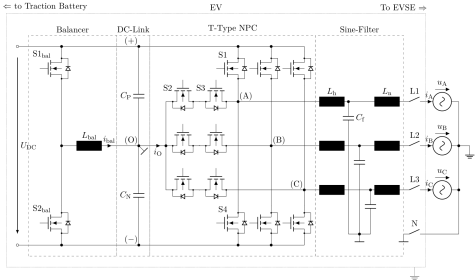Milad Khani M.Sc.
Contact
DE4LoRa is a research project investigating a new, universal traction concept. The goal is to combine ecological and economical attractivity with maximum user acceptance. The DE4LoRa concept can be categorized between long-range battery electric vehicles (BEV) and Plug-in hybrid vehicles (PHEV). The concept consists of a CNG powered internal combustion engine, two identical electric motors, all coupled together through a gearbox. The idea is to combine all drive concepts to optimize and prodive the best driving experience. Part of this concept is a new onboard charger design.

Most onboard chargers (OBC) employ a galvanic isolation and a two-stage design. In order to meet rising power demands, power densities of OBCs are required to rise as well. Simply increasing the switching frequency may not be a sufficient solution. Higher switching frequencies coupled with new topologies will be key to solving this problem. The goal of this research project is to develop a three-phase, non-isolated OBC, consisting of only one stage, allowing for higher power densities.
Non-isolated designs are more susceptible to common-mode problems. All-current sensitive type B residual current devices (RCDs) are mandated to be installed in all electric vehicle supply equipment (EVSE). Unfortunately, the generation of common-mode voltages and subsequent common-mode currents through unwanted parasitic capacitances in the system may lead to interferences with the RCDs. This work investigates this problem and implements a modulation scheme for the power electronics to minimize any occurring common-mode issues, well below the tripping limits of the usual commercially available RCDs.
The OBC is designed to operate with 800 V traction battery packs. Typical battery voltages range from 600 V to 850 V, depending on the state of charge (SOC). Due to the non-isolated nature of the presented OBC, the relationship between battery and grid voltage plays a major role. At low SOCs, in which the battery voltage stays well below 700 V, the charger will switch into a single-phase charging mode and charge the battery with reduced power. Once the battery voltage reaches a specific threshold, three-phase charging with full power takes over. It is also possible to solely operate the OBC on a single-phase grid supply with reduced power capabilities.
The proposed design also provides the ability to seamlessly transfer energy bidirectionally. This is especially interesting for vehicle to grid applications.



